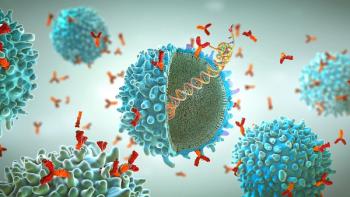
Demonstrating a Fully Continuous Bioprocess
Flexible and efficient methods are needed for biopharmaceutical manufacturing.
Continuous manufacturing for biopharmaceutical drugs offers the potential for similar advantages to those that can be obtained by continuous processing of small-molecule drugs, including higher efficiency and flexibility of scale. At Sweden’s AdBIOPRO (the Competence Centre for Advanced BioProduction by Continuous Processing), researchers from Lund University and KTH Royal Institute of Technology aim to advance understanding of continuous bioprocessing to support industry efforts.
To this end, AdBIOPRO researchers conducted a scale-up project at the Testa Center in Uppsala, Sweden, which is a pilot-scale test center that is an initiative between the Swedish government and life sciences company Cytiva. The group demonstrated that it is possible to run a large-scale, automated continuous bioprocess in which a cell culture operated in perfusion mode directly and automatically connects to a continuous purification process, says Veronique Chotteau, professor at KTH Royal Institute of Technology and head of AdBIOPRO. BioPharm International spoke with Chotteau about the group’s proof-of-concept work and the key components that are needed to run a fully continuous bioprocess that connects both upstream and downstream processing in one workflow.
Collaborative effort
BioPharm: Can you tell us more about the collaboration between the research groups at KTH and Lund University?
Chotteau (AdBIOPRO): My group at KTH is a leader in high cell-density perfusion for the production of glycoproteins. We develop methods and approaches for the development of these processes, push the limits, and identify the boundaries. Professor Bernt Nilsson's research group at Lund University is leading in modeling of continuous purification processes aiming at optimization and automation of these systems. Professor Sophia Hober is a well-recognized expert in protein engineering; her group has developed a new ligand for a new type of protein A, ZCa, that eliminates the need for very low pH for the detachment of the antibody from the protein A.
So, we are responsible for the perfusion culture; Bernt’s group for the design, realisation and automation of the continuous purification; and Sophia’s group for the new type of protein A used in the capture step. We have developed our respective parts and then put everything together thanks to four PhD students from the respective groups.
The next steps are to continue to apply this acquired knowledge for other glycoproteins, which could potentially be more challenging; to apply more process analytical technology (PAT); and to increase the level of automation. We plan to apply this successful concept of gathering multi-disciplinary expertise in close collaboration for other types of modalities, such as viral vectors for gene therapy.
Challenges for connecting upstream and downstream
BioPharm: What are the technical challenges in creating a fully continuous process?
Chotteau (AdBIOPRO): Building both purification and production in one workflow was complicated. The system is a continuous cell culture, operated in perfusion mode, that is directly and automatically connected to a continuous purification process consisting of three chromatography steps and a virus reduction step, where the continuous purification process is also completely automated. The whole process runs completely unattended from late afternoon to morning. The whole system had to be optimized and automated, while ensuring robustness.
The culture was pushed to a very high cell density of 100 x 106 cells/mL. [In this situation], small deficiencies in the feeding and aeration strategy, among other things, can rapidly lead to failure.
Classical purification processes are operated in batch mode, with each step performed batch-wise; material is stored and buffer may be changed between the different steps. In a continuous process, however, these steps are now connected automatically; the flow between the steps has to be well designed, and buffer changes have to be avoided. To achieve this, a mathematical model of the process is used for optimization, and it can also be used for process control. Furthermore, the purification process has to be robust against the variations of the cell culture process, the material harvested from the bioreactor, and the variations in the chromatography steps.
With a conventional protein A matrix, a very low pH (i.e., around 3 pH), can cause aggregation of the antibody. This aggregation represents a safety risk (because antibody aggregates are impurities, potentially triggering an immune reaction in the patient if they are present in the drug product) and a burden for the downstream steps, which need to remove these formed aggregates, thus causing a reduced yield. The new matrix ZCa has a ligand based on calcium; the presence or absence of the ligand switches the antibody-binding ability of ZCa at mild pH. In the capture step, this switch is used first to bind the antibody, then to release it. Since low pH does not need to be used, the amount of aggregates is close to zero. Since it is not necessary to remove the aggregates, the yield is very high. The potential of this matrix was demonstrated in this project at pilot scale during 300 cycles.
BioPharm: What is the importance of automation in continuous bioprocessing?
Chotteau (AdBIOPRO): Without automation, a continuous process is not possible. A well-realized automation of a continuous purification process actually provides higher yields compared to a batch process because no material is lost. We had a yield of 90% for a purification process containing three chromatography steps and a virus reduction step. This high yield was due to the automated continuous purification process, the efficient design, and the new ligand of protein A that eliminated aggregation.
Even before perfusion became popular for robust molecules such as antibodies, this mode of operation was already being used for labile proteins, such as therapeutic enzymes. The automatic renewal of cell culture medium provided in perfusion culture is highly beneficial for the cells and the product of interest, which is constantly removed from the bioreactor and separated from any proteolytic action and other deterioration. Nowadays, many antibody-derived molecules, such as bi-specific antibodies, are in biopharma drug development pipelines. These new therapeutic drugs are more challenging to manufacture than traditional antibodies, and a perfusion operation can answer that challenge. In contrast with fed-batch, where the quality profile varies with time, perfusion culture has demonstrated a stable product quality profile over time at steady-state conditions. However, other researchers have reported that the product quality profile can sometimes have a drift with time. The implementation of PAT combined with automation could possibly counteract this drift.
BioPharm: What are some of the uses of PAT in continuous bioprocessing?
Chotteau (AdBIOPRO): We could have advantageously included more PAT [in the scale-up project]. PAT could be a tool to tune the quality profile, for instance, or to improve the robustness of the continuous process with the help of feedback control. We have recently developed monitoring of antibody glycosylation with a Raman probe for perfusion processing. Based on this development, we plan to demonstrate a proof-of-concept involving feedback control of glycosylation using our newly developed feeding strategy. In collaboration with other KTH scientists, analytical chemists, and microfluidics experts within the European Union project, iConsensus, we are also working on miniaturized measurements of the antibody charge variant and the quantification of the host cell proteins (HCPs). PAT of charge-variant detection will be a precious tool to implement, since this quality attribute can also vary in the bioreactor. We are also looking at in-line sensors for the measurement of antibody titer, which will be helpful to further improve purification robustness by feedback control. Finally, HCP quantification during the purification process can be instrumental for the optimization of the process, its robustness, and on-line performance monitoring of the equipment.
BioPharm: What is the role of single-use technologies in your process?
Chotteau (AdBIOPRO): Single-use equipment has allowed us to quickly mount a completely new setting at pilot-scale of a complex system of upstream processing equipment connected to downstream processing equipment, including the seed bioreactor. This set-up has taken only a couple of days; stainless-steel equipment would have required a longer time and less flexibility in the set-up. A real advantage is to be able to do whatever you want, in particular for the connections, and to also have the flexibility to easily do modifications. Using stainless-steel equipment, all the modifications would have to be somehow planned from the beginning, which is very difficult for an R&D experiment. All the tube connections are also rapidly done with single-use equipment, while this is much slower and complex with stainless steel. Another feature is that the risk of contamination of the culture is almost none. Having run a sophisticated perfusion culture in stainless-steel equipment at pilot-scale, I can tell you that this reduced risk is really important.
Newsletter
Stay at the forefront of biopharmaceutical innovation—subscribe to BioPharm International for expert insights on drug development, manufacturing, compliance, and more.




